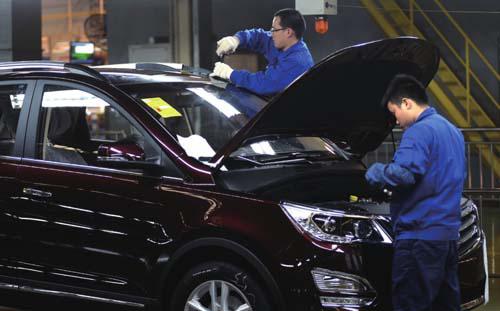Truths About China-U.S. Trade
2018-09-11ByWangYong
By Wang Yong
The Donald Trump administration is fighting a trade war with the world, in particular China. The president has slapped tariffs on Chinese goods, railing about the China-U.S. trade defi cit.
Last year, China exported goods and services worth roughly $500 billion to the United States, while the United States sent back exports worth $130 billion. The president calls that $370-billion defi cit thievery, but most economists dont see the harm it does to the United States.
The U.S. people need to hear the truth about U.S.-China trade, instead of Trumps charges of bad faith. Despite what the president says, trade between the two nations is free and fair, and the 10 following points demonstrate why.
1. Although China, as a developing country, has higher tariffs in place on U.S. goods than the United States does on those from China, its tariffs are still lower than many other developing countries, including India. Since its accession to the World Trade Organization (WTO) in 2001, China has consistently lowered its trade barriers. It has also been the fastest growing market for U.S. exports, and U.S. exporters are not stupid: They know a good deal when they see one. According to last years data from Chinas Ministry of Commerce, 56 percent of U.S. soybeans, 26 percent of Boeing airplanes and 17 percent of U.S.-made automobiles were sold in China.
2. As for goods coming into the United States, U.S. importers are not stupid either. No one is forcing them to buy Chinese goods. Inexpensive Chinese imports have helped the U.S. middle class, which has ex-perienced slow income growth for years, to buy more with the same wages.
3. It isnt Chinese barriers but U.S. export controls that limit economic exchange. Chinas trade advantage lies in its cheaper labor costs, and the U.S. advantage lies in capital and land. China exports laborintensive products to the United States, the United States exports technology and agricultural products to China. However, U.S. export policy is stricter than those of Europe, Germany in particular, and Japan, determining what and how much can be exported. Without export restrictions on 20 hi-tech products such as aircraft and aircraft engines, navigation systems, lasers and fi ber optics, the U.S.-China trade defi cit would decrease.
4. The numbers behind trade deficits can be deceiving. Take Apples iPhone for example. When iPhones arrive in the United States from China where they are assembled, their high cost adds signifi cantly to the trade imbalance in Chinas favor. But Chinese workers and factories only receive 5 percent of the value of an iPhone(mainly labor costs), while Apples design, brand and marketing account for nearly 60 percent of its value. China doesnt even provide parts for the iPhone, which come from the global supply chain and the benefits of which go to the suppliers, not to China. By one calculation, an iPhones estimated factory cost—$240—exaggerates the value of Chinas exports to the United States because China keeps less than $9 per phone.
5. When U.S. protectionists talk about the trade deficit with China, they deliberately ignore the U.S. trade surplus in services via sectors such as travel, education, banking, insurance and royalty payments. According to Chinas statistics, in 2017, that imbalance was as high as$54.1 billion, and it has risen steeply for a decade.
6. Another thing protectionists deliberately ignore is that the sales of U.S. companies in China have surpassed $500 billion. These fi rms are making huge profi ts from the fast-growing Chinese market, and their success adds to the exports of U.S. components and intellectual property (IP) rights to China.
7. As for IP, Trump constantly accuses China of stealing U.S. technology and copying its goods. Although China established IP protection comparatively late—in the 1990s—these laws are working. In 2017, Chinas external payment of IP fees reached $28.6 billion, 15 times more than when it joined the WTO in 2001, with U.S. IP owners the biggest benefi ciaries.
8. Accusing Chinese firms of forced technology transfers is another outdated charge. No laws or regulations compel such transfers; joint ventures are based on deal-by-deal negotiations and some U.S. companies are willing to transfer technology for Chinese market access. The joint ventures of General Motors and Ford, for example, have made them two of the largest automobile manufacturers in China.
9. Trump wants to contain Made in China 2025, a strategy aimed at modernizing Chinese industries and charges China with “state capitalism.” However, Chinese subsidies are in line with WTO regulations and they are available to foreign-funded enterprises too. Moreover, the United States engages in similar protectionism itself: Subsidies and defense spending have nurtured the Internet, semiconductors, nuclear power plants and military-civilian space technology.
10. Chinas trade practices are broadly in compliance with WTO rules and, like the United States, China is subject to a biennial WTO review. Since 2001, China has been accused 40 times and the United States 80 in WTO disputes. When judgments go against China, it corrects its course. The United States has obeyed the WTO much less often.
China doesnt want to fight in the escalating trade war waged by the Trump administration, but it will defend itself. At the same time, it is reaching out to other foreign investors to counterbalance U.S. actions, and the United States may lose investment opportunities if the Trump administration persists. The presidents actions are evocative of the 1930s, when Congress passed the protectionist Smoot-Hawley Tariff Act. The result was a worldwide trade confl ict, a currency war and fi nally World War II. People in the United States should remember their history and oppose Trumps trade war against China.
